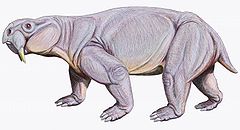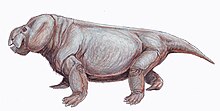Santa Maria formation
The Santa Maria Formation is a lithostratigraphic formation of sedimentary origin from the Middle Triassic of southern Brazil . It belongs to the Santa Maria supersequence from the Rósario-do-Sul group and thus to the Gondwana II supersequence deposited in the Paraná basin . The formation has an extremely rich vertebrate fauna .
etymology
The formation is named after the city of Santa Maria in the Brazilian state of Rio Grande do Sul .
stratigraphy
The Santa Maria formation comes to lie with an erosive discordance on the underlying Sanga-do-Cabral formation , into which it has cut itself with sandstone lenses and conglomerate layers of its lowest member. In the hanging wall, with a gradual change of facies , it merges into the overlying, sandy Caturrita Formation .
The Santa Maria formation is divided into two members (from young to old):
- Alemoa member
- Passo das Tropas member
Sequence stratigraphy
The 200-meter-mighty Santa Maria Supersequence, a cycle of the second order, can in turn be separated into cycles of the third order (from young to old):
- Santa Maria sequence 3 - Mata sandstone - high sea level
- Santa Maria sequence 2 - Caturrita formation (upper section) and Alemoa members (lower section) - up to 130 meters - transgression
- Santa Maria sequence 1 - Alemoa member and basal Passo das Tropas member - 50 meters - sea level depression
The Santa Maria formation thus comprises the entire Santa Maria sequence 1 as well as the lower part of the Santa Maria sequence 2.
Age
The Santa Maria Formation is not yet given an absolute age, but it is placed in the Ladinium and Carnian due to its fossil content .
Distribution area
The distribution area of the Santa Maria Formation is limited to the Brazilian state of Rio Grande do Sul. It moves in a relatively narrow (with a maximum smear width of around 30 kilometers), 250 kilometers long band in an east-west direction from Taquari to Mata .
Deposition Conditions and Facies
The Passos das Tropas member begins as a “Lowstand Systems Tract” - when the sea level dropped, it eroded heavily into its base, the Sanga-do-Cabral formation. Fine-grained to conglomerate sandstones were deposited, as well as red silt and clay stones , which were supplied by very high-energy rivers (plaited streams) with relatively little curvature . The climatic conditions were semi-arid .
The Alemoa member is a "Transgressive Systems Tract", when the sea level rose, red clay stones were sedimented. The early diagnostic carbonate contained in them suggests increasingly dry climatic conditions. The clay stones were deposited either in shallow lakes or in alluvial plains of an ephemeral pigtail system. The latter sedimentation space and the red coloration of the sediments indicate a climate with distinct seasons. The type locality of the Alemoa member is the outskirts of Santa Maria.
Fossil content
The Santa Maria sequence 1 is home to an important vertebrate biozone, the “Dinodontosaurus Assemblage Zone” , named after the dicynodontier Dinodontosaurus pedroanum . However, the biozone is not clearly defined, so a stratigraphically somewhat higher subzone can also be identified, the "Stahleckeria Zone", named after Stahleckeria potens , also a dicynodontic animal. Associated with the Dinodontosaurus biozone are the following taxa:
- Barbarianasuchus brasiliensis - Archosaur
- Candelaria barbouri - Owenetide ( Temnospondyle )
- Chiniquodon theotonicus - Cynodontier
- Exaeretodon major - Cynodontier
- Ischigualastia - dicynodont animal
- Jachaleria candelariensis - Dicynodontier
- Luangwa sudamericana - Cynodontal animal
- Massetognathus ochagaviae - Cynodontier
- Prestosuchus chiniquensis - Archosaur
- Procerosuchus celer - Archosaur
- Protheriodon estudianti - Cynodontier
- Santacruzodon hopsoni - cynodontic animal
- Spondylosoma absconditum - Archosaur
- Traversodon stahleckeria - Cynodontier
Also represented are several traversodontids and a rhadinosuchid archosaur. The main sites are at Chiniquá and Pinheiros.
The Alemoa member in the lower section of Santa Maria sequence 2 also contains a very important vertebrate biozone, the "Hyperodapedon Assemblage Zone" . The genus Hyperodapedon belongs to the rhynchosaurs and occurs with three species:
The following taxa are also associated with the Hyperodapedon Biozone:
- Aetosauroides - Archosaurs
- Cerritosausus binsfeldi - Archosaur
- Gomphodontosuchus brasiliensis - Cynodontier
- Prozostrodon brasiliensis - cynodontic animal
- Rauisuchus tiradentes - Archosaur
- Rhadinosuchus gracilis - Archosaur
- Saturnalia tupiniquim - dinosaur
- Staurikosaurus pricei - dinosaur
- Teyuwasu barbarenai - dinosaur
- Therioherpeton cargnini - cynodontic animal
The remains of a Temnospondyle also came to light . The main sites are in and around Santa Maria.
See also
Individual evidence
- ↑ Zerfass, H., Lavina, EL, Schultz, CL, Garcia, AGV, Faccini, UF and Chemale Jr, F., 2003, Sequence stratigraphy of continental Triassic strata of southernmost Brazil: a contribution to Southwestern Gondwana palaeogeography and palaeoclimate: Sedimentary Geology, v. 161, p. 85-105.
- ^ Fonseca, MM, and Scherer, CMS, 1998. The Middle and Late Triassic of South Brazilian Gondwanaland: a process oriented analysis on the fluvial deposits: Hallesches Jahrbuch für Geoswissenschaften, v. 5, p. 51-52.
- ↑ Holz, M., 1993, A origem da cor vermelha nos sedimentitos do Triassico Medio no Gonduana Sul-Brasileiro: Acta Geologica Leopoldensia.
swell
- Langer, MC, Ribeiro, AM, Schultz, CL & Ferigolo, J. The Continental Tetrapod-Bearing Triassic of South Brazil. In: Lucas, SG and Spielmann, JA, eds., 2007, The Global Triassic. New Mexico Museum of Natural History and Science Bulletin 41.


